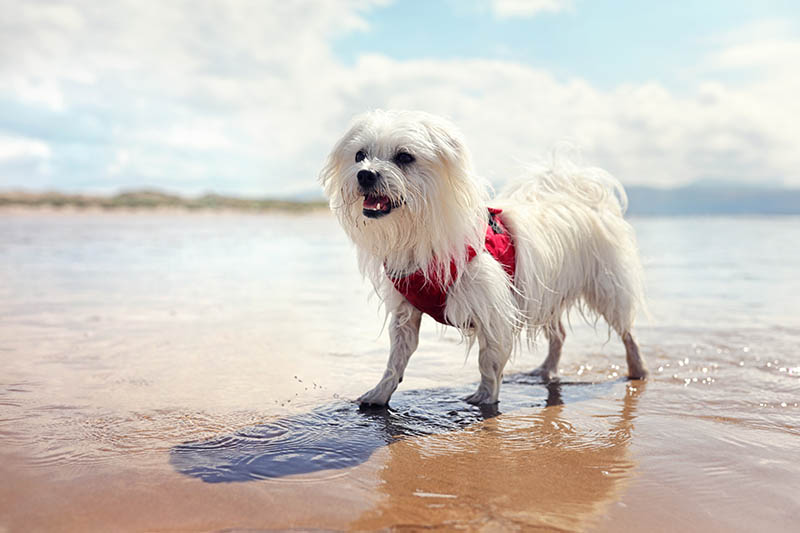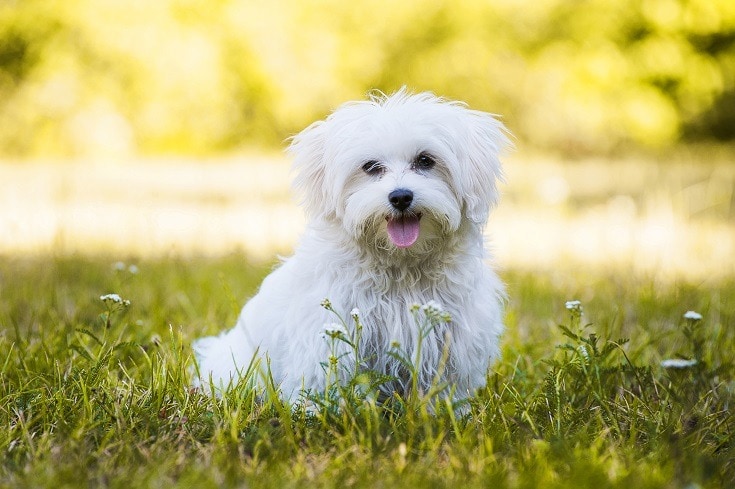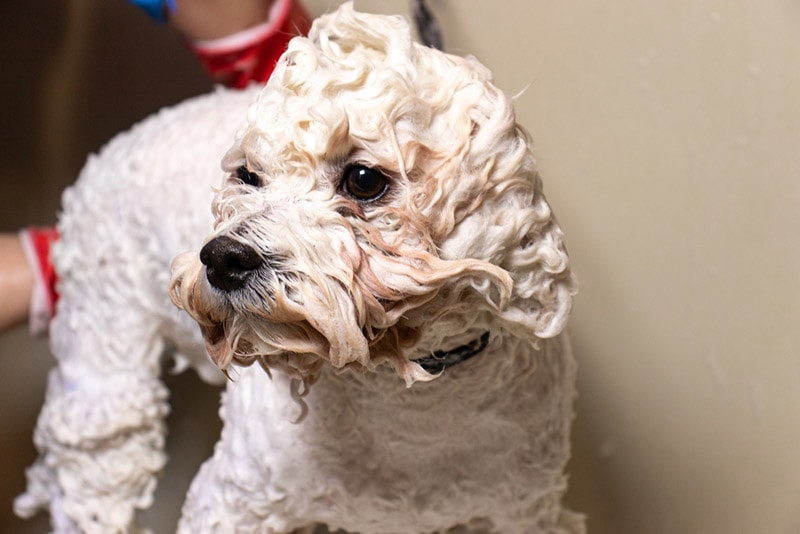Can Maltese Swim? The Surprising Answer

Updated on

Who doesn’t love Maltese dogs, right? They are delicate, affectionate, and full of life. Many centuries ago, these chaps were the go-to companions for royal, aristocratic families. The silky, luxurious coat is what makes them so popular. But they’re also very friendly, supportive, and energetic.
Do Maltese love to swim, though? The answer is no: technically, they can swim, but they’re NOT good at it.
That said, if you train a pup at a very young age, it will be able to swim. But don’t expect to achieve any groundbreaking results. Naturally, Maltese are not built for swimming. How much exercise do they need, then? Should you make swimming a part of the routine? Let’s talk about that right now!
Are These Dogs Physically Active?
Maltese are full of energy, but they’re not the most demanding breed—far from that. They only require minimal activity throughout the day to stay in shape. So, if you’re a busy person and are a bit worried that you won’t have the time to exercise with a pet, Maltese will be a great choice. That said, these sweet, gentle dogs do have playful, curious personalities.
If you’re a big fan of intelligent games (like when the four-legged bud has to find something hidden), you’ll have a blast with a Maltese! Or just take it with you on your next jog in the park. Even when left unattended, this dog will be able to keep itself busy and entertained. Don’t leave it alone for too long, though: otherwise, separation anxiety might kick in.

Do They Like Water? Are Maltese Good Swimmers?
So, can we say that Maltese and water are a match made in Heaven, or not? Well, it’s a gray area. The good news is that most Maltese dogs can “handle” water without breaking a sweat (unlike cats). But this doesn’t mean they’re inherently good at swimming. Start slow; if it’s a pup, NEVER throw it into a large pool and see what happens! Instead, introduce it to a tiny pool.
Keep a close eye on the dog. Do you see signs of anxiety? Is the dog running away from the water and not deliberately stepping its feet into the pool? If so, you need to leave the Maltese alone for a day or two before you try again. Sometimes, frequent exposure to water can lead to health issues like rheumatism and arthritis. That’s why it’s important to be patient and never rush things.
Can You Train a Maltese Into a Better Swimmer?
Yes, since Maltese are obedient dogs and follow commands willingly, it may be possible to make them better at swimming. Do keep in mind, though, that this breed has never been anywhere close to the water for thousands of years. So, it’s only natural if your pet is not very enthusiastic about the pool. On top of that, just like most breeds with long coats, Maltese don’t like how the water feels.
When the fur is soaked, it becomes quite heavy (making it harder to move) and takes forever to dry. So, do Maltese like water? Not really: it’s like jumping into a pool while fully clothed! Now, the biggest argument for teaching a Maltese pup (10–12 weeks old) to swim is safety. Sadly, in the States, up to 5,000 dogs drown per year.

How Much Exercise Does This Breed Need?
These dogs are always happy to do something fun with their owners. But you won’t have to exercise with them for 3–4 hours to keep the Maltese healthy and fit. Short daily walks around the neighborhood, combined with a proper diet, should be enough. If you only have a tiny backyard or a large enough living room, 20–30 minutes of playtime is all this toy dog is going to need.
And keep this in mind when trying to teach the Maltese new tricks: pushing it to the limit won’t help the dog learn new moves faster. Instead, it will put unnecessary strain on its joints. Even if the pooch is obese, consult your veterinarian and let them come up with the right routine that will be equally effective and safe for the tiny member of your family.
Keeping a Maltese Safe: a Detailed Guide
Don’t let the cute faces and tiny bodies fool you—the Maltese are quite strong, capable dogs. But they do rely on their human parents quite a lot. To keep your toy dog safe, healthy, and happy, you need to master the art of proper feeding, grooming, and training. Here’s how you do that:
- Only buy premium-quality food. Maltese have high nutritional needs, and the only way to meet them is to invest in quality meals and snacks. Make sure the food doesn’t include any flavoring or coloring. Chemical preservatives are out of the question as well. Additives take a toll on the skin, coat, and digestive system. All-natural, 100% US-made food will boost the dog’s immune system and keep it fit.
- Always filter the water. Depending on where you live, tap water can be poisonous to a Maltese dog. We’re talking about harmful chemicals like chlorine, fluoride, and DDT, to name a few. Thankfully, this problem can be avoided by installing a cheap filter on the sink. You may also buy filtered water, but there’s no guarantee it won’t be contaminated.
- Make regular veterinary visits. We can’t stress how important it is to stick to regular vet checks! The sooner animal doctors reveal potential health issues, the easier it will be to overcome them. Maltese should be checked once a year. If the dog is 8–10 years old, visit the vet twice as often.
- Use a booster when driving the dog. These puppies are quite fragile, which is why it’s recommended to buy a dog seat for safe travels. Accidents on the road happen quite often, and the canine seat can be the only thing keeping the dog from harm’s way.

Grooming Tips for a Maltese Owner
That million-dollar coat sure does look gorgeous, but you will have to take proper care of it. To avoid tangles and mats, make a habit of brushing and combing the dog once a day. Be very gentle and don’t rush it! Unlike most dog breeds, Maltese are big fans of bathing. Do it 2–4 times a month or more often (depending on how active the dog is). This is important: never brush the coat when it’s dry.
Instead, moisturize it a bit with a conditioner first. The ears, in turn, should be checked and cleaned once a week; trim the nails every 2–3 weeks. And don’t forget to brush its teeth! The Maltese are a toy breed; so, do this every day and perform regular checks at a veterinary clinic. And do you notice tear-staining around its big, dark eyes? Have the vet check them on your next visit.
Conclusion
Peaceful, responsive, and ever-ready to please its owners, the Maltese is one of the best toy dog breeds in history. It’s very active, too, but doesn’t crave your attention 24/7, despite being highly affectionate. You can walk or run with the dog, help it learn new tricks, and, of course, teach it how to swim. But we wouldn’t necessarily recommend that.
Most Maltese dogs aren’t afraid of the water and will be able to swim if taught properly. However, swimming can be a stressful activity for the pooch and even make it sick when unsupervised. Besides, you will have to put in long hours into training. So, the two of you might be better off playing in the yard!
Related Reads:
Featured Image Credit: Brian A Jackson, Shutterstock












